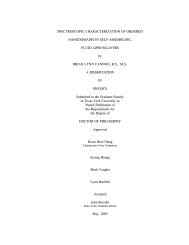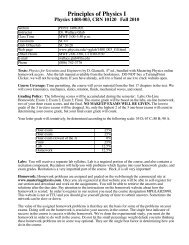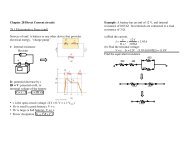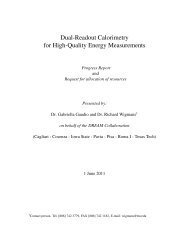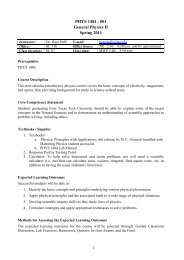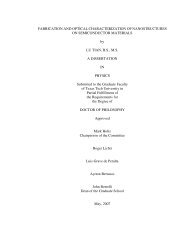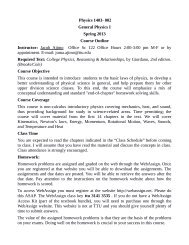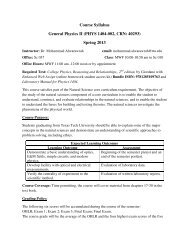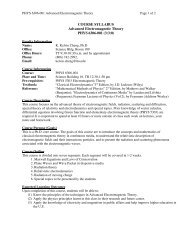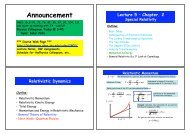Version One â Homework 1 â Juyang Huang â 24018 â Jan 16 ...
Version One â Homework 1 â Juyang Huang â 24018 â Jan 16 ...
Version One â Homework 1 â Juyang Huang â 24018 â Jan 16 ...
You also want an ePaper? Increase the reach of your titles
YUMPU automatically turns print PDFs into web optimized ePapers that Google loves.
<strong>Version</strong> <strong>One</strong> – <strong>Homework</strong> 1 – <strong>Juyang</strong> <strong>Huang</strong> – <strong>24018</strong> – <strong>Jan</strong> <strong>16</strong>, 2008 4<br />
The electric field strength E ∝ 1 r 2 , so<br />
tan θ = F 1,3<br />
F 1,2<br />
( )<br />
θ = tan −1 F1,3<br />
F 1,2<br />
( 1.34813 × 10<br />
= tan −1 −5 )<br />
N<br />
2.99585 × 10 −6 N<br />
= 77.4712 ◦<br />
E A<br />
E B<br />
=<br />
keywords:<br />
1<br />
r 2 A<br />
1<br />
r 2 B<br />
= r2 B<br />
r 2 A<br />
=<br />
(2 r)2<br />
r 2 = 4 .<br />
below the negative x-axis. From the positive<br />
x-axis, the angle is<br />
−180 ◦ + 77.4712 ◦ = −102.529 ◦ .<br />
Two Charge Field<br />
23:13, trigonometry, multiple choice, > 1 min,<br />
wording-variable.<br />
008 (part 1 of 3) 10 points<br />
Two point-charges at fixed locations produce<br />
an electric field as shown below.<br />
keywords:<br />
AP B 1993 MC 68<br />
23:07, trigonometry, multiple choice, < 1 min,<br />
fixed.<br />
007 (part 1 of 1) 10 points<br />
The diagram shows an isolated, positive<br />
charge Q, where point B is twice as far away<br />
from Q as point A.<br />
A<br />
X<br />
B<br />
+Q A B<br />
Y<br />
0 10 cm 20 cm<br />
The ratio of the electric field strength at<br />
point A to the electric field strength at point<br />
B is<br />
1. E A<br />
E B<br />
= 8 1 .<br />
2. E A<br />
E B<br />
3. E A<br />
E B<br />
= 2 1 .<br />
4. E A<br />
E B<br />
= 1 1 .<br />
5. E A<br />
E B<br />
= 1 2 .<br />
Explanation:<br />
= 4 1 . correct<br />
Let : r B<br />
= 2 r A<br />
.<br />
A negative charge placed at point X would<br />
move<br />
1. toward charge B. correct<br />
2. toward charge A.<br />
3. along an equipotential plane.<br />
Explanation:<br />
The electric field runs from a positive potential<br />
to a negative potential, so it points<br />
from a positive charge to a negative charge.<br />
Therefore the charge B is positive. A negative<br />
charge will move toward a positive potential,<br />
which creates lower potential energy and a<br />
higher kinetic energy.<br />
009 (part 2 of 3) 10 points<br />
The electric field at point X is





